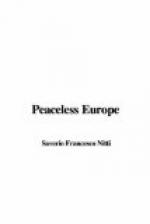Great Britain, proud of her “splendid isolation,” and ruler of the seas, traded in every country of the world. Having the vastest empire, she was also financially the greatest creditor country: creditor of America and Asia, of the new African states and of Australia. Perhaps all this wealth had somewhat diminished the spirit of enterprise before the War, and popular culture also suffered from this unprecedented prosperity. There was not the spasmodic effort noticeable in Germany, but a continuous and secure expansion, an undisputed supremacy. Although somewhat preoccupied at Germany’s progress and regarding it as a peril for the future, Great Britain attached more importance to the problems of her Empire, namely to her internal constitution: like ancient Rome, she was a truly imperial country in the security of her supremacy, in her calm, in her forbearance.
France continued patiently to accumulate wealth. She did not increase her population, but ably added to her territory and her savings. Threatened with the phenomenon known to political economists under the name of “oliganthropy,” or lack of men, she had founded a colonial empire which may be regarded as the largest on earth. It is true that the British colonies, even before the War, covered an area of thirty million square kilometres, while France’s colonial empire was slightly over twelve millions. But it must be remembered that the British colonies are not colonies in the real sense of the word, but consist chiefly in Dominions which enjoy an almost complete autonomy. Canada alone represents about one-third of the territories of the British Dominions; Australia and New Zealand more than one-fourth, and Australasia, the South African Union and Canada put together represent more than two-thirds of the Empire, while India accounts for about fifty per cent. of the missing third. After England, France was the most important creditor country. Her astonishing capacity for saving increased in proportion with her wealth. Without having Germany’s force of development and Great Britain’s power of expansion, France enjoyed a wonderful prosperity and her wealth was scattered all over the world.
Italy had arisen under the greatest difficulties, but in less than fifty years of unity she progressed steadily. Having a territory too small and mountainous for a population already overflowing and constantly on the increase, Italy had been unable to exploit the limited resources of her subsoil and had been forced to build up her industries in conditions far less favourable than those of other countries. Italy is perhaps the only nation which has succeeded in forming her industries without having any coal of her own and very little iron. But the acquisition of wealth, extremely difficult at first, had gradually been rendered more easy by the improvement in technical instruction and methods, for the most part borrowed from Germany. On the eve of the War, after a period of thirty-three years, the Triple Alliance had rendered the greatest services to Italy, fully confirming Crispi’s political intuition. France, with whom we had had serious differences of opinion, especially after the Tunis affair, did not dare to threaten Italy because the latter belonged to the Triple Alliance, and for the same reason all ideas of a conflict with Austria-Hungary had been set aside because of her forming part of the “Triplice.”




